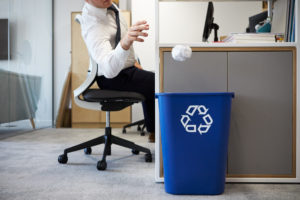Emissions from businesses are often associated with smokestacks and heavy industrial production facilities. Yet in reality, all businesses generate emissions, and rather than being limited to manufacturing processes, they are produced at every stage of the business cycle.
In fact, from the production of new products through the transportation of goods to the use of computers and office supplies, every business has a clearly defined carbon footprint associated with its daily operations.
These emissions released by businesses across a range of sectors pose a real environmental and social threat. Greenhouse gasses such as carbon dioxide and methane trap heat in the atmosphere and accelerate global warming, whilst particulate-heavy emissions and gasses such as ozone increase the risk of respiratory and circulatory problems for those living nearby.
As such, it is imperative that business owners work to reduce their company’s emissions. On the one hand, businesses are one of the key sources of emissions in the US, with industry producing 23%, commerce producing 7%, agriculture producing 10%, and transportation producing 29%, (much of which is business-related transport). On the other hand, businesses are a key catalyst of change.
Generally speaking, businesses have greater resources at their disposal than many individuals and have more freedom and flexibility than government bodies. Put simply, this means businesses have the power to reduce emissions faster and more effectively than any other type of organization.
This, in tandem with increased consumer demand for “green” products and services, is encouraging more businesses than ever before to seek emission reductions across a broad range of sectors. But how can your business achieve this? And how do you identify the areas in which you can improve? To help you get started, here we explore a range of suggestions and company initiatives to help you reduce the carbon footprint of your business.
Recycle
 Recycling is the transformation of products that are destined to be disposed of into new products or resources. Therefore, recycling not only mitigates the production of emissions associated with the creation of new goods and extraction of raw materials, but also prevents, or at least delays those emissions associated with landfills. This is a great first step towards reducing your company’s carbon footprint, as it can be quickly and easily implemented in a number of ways.
Recycling is the transformation of products that are destined to be disposed of into new products or resources. Therefore, recycling not only mitigates the production of emissions associated with the creation of new goods and extraction of raw materials, but also prevents, or at least delays those emissions associated with landfills. This is a great first step towards reducing your company’s carbon footprint, as it can be quickly and easily implemented in a number of ways.
One of the most popular methods is by partnering with a responsible waste management company. For example, RTS can offer you guidance in effectively separating your types of waste, before efficiently collecting and responsibly redirecting in the most environmentally-friendly way possible.
However, you can also recycle within your own business. For example, there are many ways that construction and demolition waste can be recycled on-site, such as pulverizing bricks and concrete for use as aggregate for new projects. Similarly, workers in the agricultural industry can use cardboard and old packaging as an effective source of mulch, or as an ingredient in compost. By finding ways to recycle your waste within your business, you can effectively keep resources within the loop without relying on local facilities.
Reuse
Reuse is the practice of using products and resources multiple times for their originally intended purpose or a similar purpose or cycling them through multiple owners. Reuse offers any business a powerful opportunity to reduce its carbon footprint, although it is currently a drastically underused practice.
For example, the EPA found that, in 2018, 21.8% or 82.2 million tons of municipal solid waste consisted of containers and packaging. Whilst these numbers are alarming, it demonstrates an excellent opportunity for business to implement change.
There are plenty of ways in which the introduction of closed-loop packaging in the retail and food sector can be used to reduce emissions. This is packaging that can easily be returned to the point of production or retail for reuse. South Africa demonstrates this well, as its returnable bottling system annually diverts 1.9 million tons of glass waste from landfills. This is equal to an enormous 1,159,000,000 kg of Co2.
For retailers, similar models can be introduced into most businesses, such as by selling long-life or bulk goods in glass containers or sacks, for which customers are reimbursed upon return to the retailer or producer. Equally, supermarkets can offer cloth bags in which customers can buy loose fruits and vegetables, and beauty retailers can offer their products by weight, dispensing them from large in-store containers into smaller containers brought by customers from their homes.
It’s also becoming increasingly common for couriers to use multi-use packaging, whether in the form of reusable cardboard, or envelopes equipped with several different sets of adhesive strips for repeated use. But the opportunities don’t stop there, and even buildings can now be designed to enable easy deconstruction so that their raw building materials can be simply integrated into new constructions.
Reduce transport emissions
For any business seeking to reduce their emissions, it’s essential to consider the impact of transport. The Department of Transportation reports that, since the 90s, the emissions from transport have grown faster than in any sector other than electric power, with a 66% increase in emissions from lightweight trucks, and a 76% increase from heavyweight trucks. As transportation is the largest source of emissions in the US and accounts for one-quarter of emissions globally, it’s clearly an area that requires rapid change.
 The UN has determined that zero-emissions vehicles must become the default choice for the shipping sector. Investing in a green fleet of vehicles is certainly an effective change that you can undertake in your business, although it can require a large amount of capital upfront. Fortunately, there are lots of simpler and cheaper ways that companies can reduce the carbon emissions of business travel and transport in the short term.
The UN has determined that zero-emissions vehicles must become the default choice for the shipping sector. Investing in a green fleet of vehicles is certainly an effective change that you can undertake in your business, although it can require a large amount of capital upfront. Fortunately, there are lots of simpler and cheaper ways that companies can reduce the carbon emissions of business travel and transport in the short term.
Making simple changes, such as improving the environmental awareness of your drivers can be a great start, as idling, accelerating and braking practices can all produce unnecessary emissions. Working with companies that offer tech and training to mitigate wasteful practices can be a good starting point, as can encouraging your staff to work from home, carpool, or use public transport where possible.
You can also make conscientious decisions about the transport practices of other businesses with whom you work. For example, RTS has developed and utilized sophisticated routing technology to enable the haulers to collect and deliver waste in the most fuel and time-efficient manner possible, thus reducing the carbon footprint for clients.
Switch to reusable energy
Whether you’re working in industrial production, agriculture, or even retail, your power sources can become greener.
The EPA has identified that, although only 24% of the electricity in the US is produced by burning coal, it is responsible for 61% of the sector’s emissions. In contrast, 20% of US electricity is produced by nuclear power, and 18% comes from other renewable sources. 
Many of these alternatives to coal, including nuclear, hydroelectric, solar, and wind power produce no emissions at all after taking in the facility’s production costs. Switching to an emission-free electricity source not only helps to mitigate your business’s carbon footprint, but also helps to bolster your green credentials for consumers. Whilst switching to a greener energy supplier may seem daunting, this article offers clear advice on how to make the change simply and easily.
Utilize natural space
Utilizing natural space on your business premises can be a great way to reduce emissions, and even actively sequester carbon. For example, introducing a staff garden can be a functional and beautiful example of how to reduce the carbon footprint of your company.
 Depending on your needs, your staff garden can be planted to reduce sunlight falling onto your building, creating a natural filter that helps to reduce the temperature, and subsequently reduces the energy costs of air conditioning. Your site can also include a composting option, creating a way for you to direct cardboard and food scraps into a source of carbon sequestration, whilst providing high-quality soil and fertilizer to keep your garden green.
Depending on your needs, your staff garden can be planted to reduce sunlight falling onto your building, creating a natural filter that helps to reduce the temperature, and subsequently reduces the energy costs of air conditioning. Your site can also include a composting option, creating a way for you to direct cardboard and food scraps into a source of carbon sequestration, whilst providing high-quality soil and fertilizer to keep your garden green.
Most importantly, your staff garden can be a site for planting more trees, which is another way to sequester carbon whilst also actively producing oxygen while also providing a fantastic source of wellbeing for your staff. Taken together, this means an emission-reducing environment where staff can unwind and self-regulate, or enjoy informal meetings or meals. If properly explored, this source of well-being can also be used to encourage your staffs’ support of your initiatives to reduce emissions in other ways.
Undergo a waste analysis
Emissions and waste go hand in hand, and identifying how your business can reduce waste is a fundamental step in reducing its emissions. In fact, whilst there may be changes you can make to reduce your waste and subsequently cut emissions independently, it is possible to perfectly optimize your emission output with the help of a waste analysis professional.
 Beginning by examining your waste outputs and how they are handled, a comprehensive waste analysis will enable you to build a personalized waste plan that minimizes landfill material and promotes a more circular economy. A free waste assessment with RTS can help you achieve this, and with support from our TRUE advisors, you can drill down into your waste generation and identify ways to implement a range of zero-waste practices.
Beginning by examining your waste outputs and how they are handled, a comprehensive waste analysis will enable you to build a personalized waste plan that minimizes landfill material and promotes a more circular economy. A free waste assessment with RTS can help you achieve this, and with support from our TRUE advisors, you can drill down into your waste generation and identify ways to implement a range of zero-waste practices.
Reducing your company’s emissions is a vital stage in building a healthier relationship with the world in which it operates. Only by conscientiously and proactively understanding how your business generates those emissions can you contribute to a more sustainable economy and a more environmentally friendly future.
For more information on how you can improve your business’s relationship with waste, visit the RTS website, or check out the RTS blog for more inspiration.

